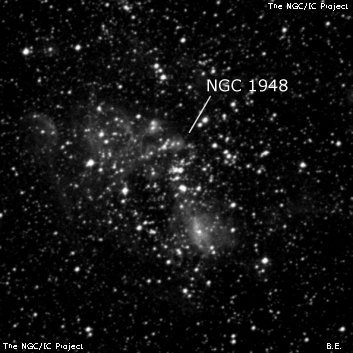NGC/IC Project Restoration Effort
(This is a very very beta version)
NGC1948


Basic Information
Location and Magnitude
Right Ascension: 5:25:46.3
Declination: -66:16:1
Constellation: DOR
Visual Magnitude: 11.6
Historic Information
Discoverer: Dunlop
Year of discovery: 1826
Discovery aperture: 9.0
Observational
Summary description: Cl, cL, Ri, st 13
Sub-type: OCL+EN
Steve's Notes
=====
NGC 1948
24" (4/11/08 - Magellan Observatory, Australia): this is a large, well-resolved star cloud (stellar association LH 52) and emission nebula, ~6' diameter, with a roughly diamond shape. Approximately 60 stars were resolved at 260x over haze. A fairly large, nebulous knot (LMC-N48B) was visible on the southwest side, ~1.2' diameter, and it responded well to a UHC filter. A couple of other very small knots or clumps of stars were visible at the center (LMC-N48A and N48C). Supernova remnant LMC-N49 lies 11' NNE. Two parallel stream of stars and unresolved haze (roughly 3' apart), oriented SW to NE, extends southwest from NGC 1948 through NGC 1946 to NGC 1945. The western string is brighter, consisting of a number of mag 12-14 stars along with an unresolved glow (stars or nebulosity) extending at least 10'.
LMC N49 is the brightest supernova in the LMC and it harbors a powerful pulsar. At 260x unfiltered, it appeared as a bright "U" shape just under 1' in diameter with the center of the "U" at the east end (base oriented SW-NE) and open on the west side. The interior is much dimmer than the rim. The brightest spot is right at the east end, though the rim is much brighter and better defined along the entire base. The northern bar of the "U" side is fainter and oriented NW-SE with some haze spreading into the interior. The southern bar is brighter and narrower. A UHC filter increased the contrast and there were hints of more complex filamentary structure. Located 3.7' ENE of mag 9.0 HD 36257. Open cluster S-L 463, which appears as a very small knot attached to a star, is located 2.4' NE.
13.1" (2/20/04 - Costa Rica): at 105x this is a fairly large star group in the LMC. Over a dozen mag 12-13 stars are resolved in a triangular group, ~6' diameter, over unresolved background haze or possibly nebulosity. NGC 1978, a bright "blue globular", lies 18' E.



